
Audi AG is a German automotive manufacturer of luxury vehicles headquartered in Ingolstadt, Bavaria, Germany. A subsidiary of the Volkswagen Group, Audi produces vehicles in nine production facilities worldwide.
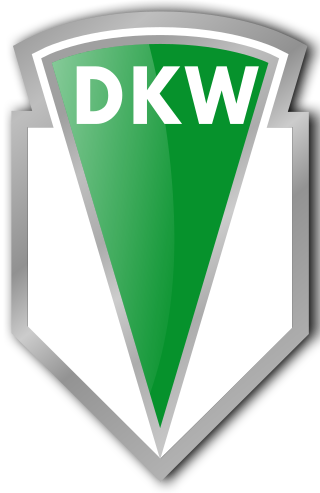
DKW was a German car- and motorcycle-marque. DKW was one of the four companies that formed Auto Union in 1932 and thus became an ancestor of the modern-day Audi company.
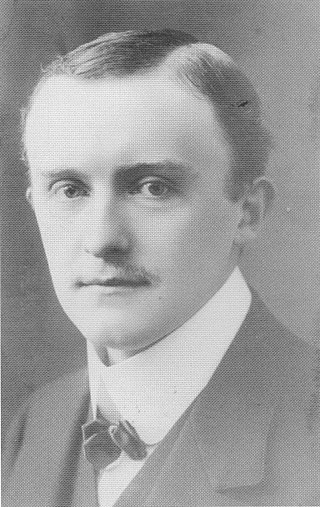
Jørgen Skafte Rasmussen was a Danish engineer and industrialist.

Auto Union AG was an amalgamation of four German automobile manufacturers, founded in 1932 and established in 1936 in Chemnitz, Saxony. It is the immediate predecessor of Audi as it is known today.
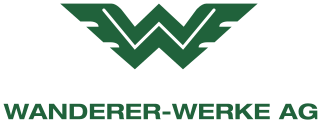
Wanderer was a German manufacturer of bicycles, motorcycles, automobiles, vans and other machinery. Established as Winklhofer & Jaenicke in 1896 by Johann Baptist Winklhofer and Richard Adolf Jaenicke, the company used the Wanderer brand name from 1911, making civilian automobiles until 1941 and military vehicles until 1945.

Horch was a car manufacturer, founded in Germany by August Horch & Cie at the beginning of the 20th century.

F103 is the internal designation for a series of car models produced by Auto Union GmbH in West Germany from 1965 to 1972, derived from the earlier DKW F102. To signify the change from a two-stroke to four-stroke engine, the DKW marque was dropped in favour of Audi, a name that had been dormant since before the Second World War.

The Auto Union 1000 is a luxury compact front-wheel drive automobile manufactured by Auto Union GmbH between 1958 and 1969. It was the first model branded as an Auto Union by the manufacturer since the 1930s; it replaced the DKW 3=6, although the latter continued in production, until the end of 1959. The two cars were broadly similar, but the new car had its two-stroke engine enlarged to 981 cc yielding a 10% - 37% power increase.
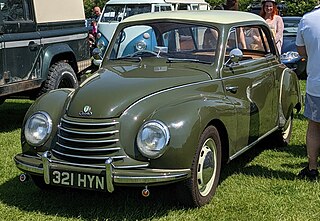
The DKW 3=6 is a compact front-wheel drive saloon manufactured by Auto Union GmbH. The car was launched at the Frankfurt Motor Show in March 1953 and sold until 1959. It carried the name Sonderklasse on the right hand fender of all steel bodied models – this being part of the model name for this range. The first model in the range was named by factory project number, DKW F91, which was replaced by the F93 and F94 models from the 1956 model year. The F93 and F94 models were referred to by Auto Union as the "Big DKW 3=6". From 1958, by which year the car's successor, the Auto Union 1000 Coupe de Luxe, was already being sold and the earlier version had therefore become, in essence, a ‘run-out’ model, it was known more simply as the DKW 900.

The Auto Union Grand Prix racing cars types A to D were developed and built by a specialist racing department of Auto Union's Horch works in Zwickau, Germany, between 1933 and 1939, after the company bought a design by Dr. Ferdinand Porsche in 1933. The Auto Union type B streamlined body was designed by Paul Jaray.

The Audi 920 is a car introduced in 1938 by the Audi division of Auto Union to replace the Audi Front UW 225. Its engine was a shortened version of the eight-cylinder in-line engine used by sister company Horch. The car was planned to occupy a niche in the Auto Union range between the large Horch products and the middle market cars produced by Wanderer. Audi had no stand-alone production facilities at that time and the car was produced, like its predecessor, at the Horch plant.

The Wanderer W22 was an upper-middle-class six-cylinder sedan introduced by Auto Union under the Wanderer brand in 1933. It replaced the W20 8/40 PS, from which it inherited its OHV engine, developed by Ferdinand Porsche.
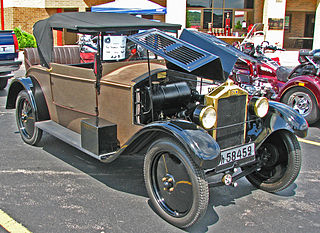
The DKW Typ P was the first motor car made by DKW. It was a light-weight design with a unit body made of wood and imitation leather. It was powered by a two stroke inline twin engine.

The Audi Type P was a small two-door sedan/saloon car introduced by Audi in 1931. It was discontinued by 1932.

The DKW F1 was a small car produced by DKW between 1931 and 1932. It was launched at the Berlin Motor Show in February 1931.

The DKW F2, firstly marketed as "DKW Meisterklasse", is a front wheel drive economy car, produced from 1932 to 1935 at the company’s Zwickau plant. DKW launched the F2 model at the Berlin Motor Show in April 1932. It shared its 584cc engine and drivetrain with its DKW F1 predecessor, but offered a longer wheelbase and a larger body.

The DKW Typ 4=8 is a small rear-wheel drive two-stroke V4 engined car produced at the company's Spandau plant by DKW. It was launched at the Berlin Motor-show in 1929 as a successor to the DKW Typ P built at the same factory, although the DKW Typ P 4=8 was significantly larger than the Typ P: in terms of market positioning a more direct successor to the DKW Type P was probably the DKW F1 produced in Zwickau from 1931.

The Adler Primus is a small family car introduced by the Frankfurt based auto-maker, Adler in March 1932. In a move reminiscent of British Leyland in the 1970s, Adler launched two similarly sized cars in the same year, one of which followed the then new trend set by DKW for front-wheel drive, and one respecting the conventional rear-wheel drive configuration still used by the market leader, Opel.

The Adler Trumpf is a small family car introduced by the Frankfurt based auto-maker, Adler in March 1932, with Trumpf production fully starting in the late summer that year. In a move reminiscent of British Leyland in the 1970s, Adler launched two similarly sized cars in the same year, one of which followed the 1931 DKW F1's then innovative front-wheel drive layout, and the other model using the conventional rear-wheel drive configuration still used by then market leader, Opel's 1.2 litre 'model 6'.

The August Horch Museum Zwickau is an automobile museum in Zwickau, Saxony, Germany. Opened in 2004, it covers the history of automobile construction in Zwickau, the home of Horch and Audi prior to World War II, and Trabant during the Cold War-era German Democratic Republic.





















